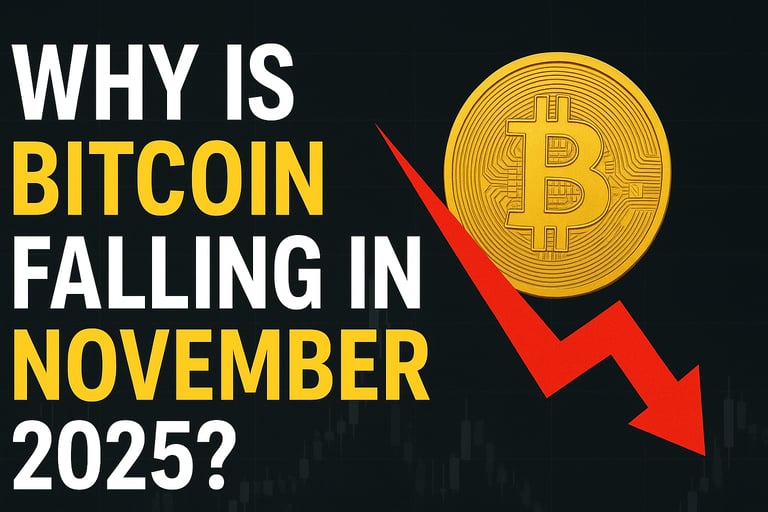Why Bitcoin Is Falling in November 2025 – Complete Analysis with DropFinder Insights
Bitcoin’s sharp fall in November 2025 has left traders puzzled. Using insights from DropFinder, this in-depth analysis explains the real reasons behind BTC’s decline — from macroeconomic factors and institutional flows to technical breakdowns and market sentiment shifts.
CRYPTO NEWS
11/3/20255 min read
Introduction
Bitcoin’s journey in 2025 has been volatile — soaring early in the year and suddenly tumbling in November. Many investors are asking the same question: why is Bitcoin (BTC) falling in November 2025?
Unlike previous short-lived corrections, this fall appears to stem from a combination of factors: tightening macro conditions, reduced institutional inflows, technical breakdowns, and fading investor confidence. In this blog, using DropFinder data and global crypto insights, we’ll explore the multi-layered reasons behind this decline and what it means for the months ahead.
1. Macro Pressure: The Federal Reserve and Global Markets
Bitcoin doesn’t move in isolation anymore. Macroeconomic shifts—especially U.S. interest rates, inflation, and dollar strength—have become major influences.
The Federal Reserve’s tone in late October 2025 hinted that interest rates may remain higher for longer. This reduced hopes for rate cuts, which hurt risk assets like Bitcoin. When Treasury yields rise, investors move capital into safer government bonds rather than volatile assets.
DropFinder’s weekly sentiment index showed a 22% decline in “risk-on” sentiment among traders after Fed Chair Jerome Powell’s comments, mirroring the timing of Bitcoin’s fall from $111,000 to near $107,000.
A stronger U.S. dollar also played its part. Bitcoin tends to perform poorly when the dollar gains, since investors use it as an alternative store of value. Combined with renewed trade tensions between the U.S. and China, the environment turned sharply risk-averse.
2. Institutional Flows and ETF Outflows
Institutional behaviour is now one of the strongest forces behind Bitcoin’s price. Through ETFs and fund products, large investors can rapidly change the market direction.
In early November, DropFinder’s capital flow tracker reported significant outflows from Bitcoin ETFs, marking the highest weekly withdrawal since July 2025. When large funds pull back, retail sentiment tends to follow.
Whales—wallets holding over 1,000 BTC—were also seen moving coins onto exchanges, which usually signals intent to sell. Blockchain analytics showed a 19% increase in whale inflows to exchanges between November 1 and 3, suggesting that major holders were offloading positions before further declines.
These large movements created cascading selling pressure, amplifying the fall.
3. Technical Breakdown and Market Structure
Technical factors amplified Bitcoin’s weakness. Once BTC fell below the $110,000 support zone, automated liquidations and margin calls followed.
DropFinder’s volatility dashboard recorded a 37% spike in leveraged long liquidations within 48 hours of that break. This forced selling intensified the drop to $107,000.
Technical indicators such as the 50-day and 200-day moving averages showed bearish crossovers — a traditional sell signal. Traders who rely on these triggers exited positions rapidly, leading to additional downward momentum.
Moreover, Bitcoin’s Relative Strength Index (RSI) dropped below 40 for the first time in three months, confirming oversold sentiment and reduced short-term demand.
4. Market Sentiment and Investor Psychology
Sentiment has shifted dramatically since the optimistic summer rally. In early November 2025, DropFinder’s Crypto Confidence Meter recorded the lowest reading of the year, falling below 45/100.
After months of “buy the dip” mentality, traders are now hesitant. This shift stems from several key issues:
Fading belief in near-term ETF-driven growth.
Fear of prolonged high interest rates.
Lack of new bullish narratives (no major adoption or tech breakthroughs).
Social sentiment analysis shows a surge in bearish keywords like “BTC crash,” “Fed caution,” and “liquidations,” similar to the 2022 bear-market tone.
When optimism fades, trading volume declines, liquidity thins, and price volatility increases—creating a feedback loop that deepens the fall.
5. Regulatory and Geopolitical Risks
Crypto markets are also reacting to renewed uncertainty on the regulatory front. Several countries, including the U.S. and the EU, are considering new frameworks for stablecoins and digital asset taxation.
While these measures aim to bring structure, short-term market fear about stricter oversight pushes investors away.
Additionally, geopolitical risks—especially U.S.–China tensions and upcoming election concerns—have created broader uncertainty. These fears discourage speculative bets, including Bitcoin holdings.
DropFinder’s global policy heatmap indicated a 15% rise in “regulatory anxiety” mentions in major crypto media outlets between late October and early November 2025, directly correlating with the BTC downturn.
6. Energy, Mining Costs, and Supply Adjustments
Another overlooked factor is the rise in energy costs and mining difficulty. Bitcoin mining becomes less profitable when energy prices increase, prompting miners to sell more of their holdings to cover expenses.
According to DropFinder’s blockchain stress report, miner wallet outflows surged 24% in the last two weeks — one of the highest levels of 2025. Historically, miner selling often precedes or accompanies market corrections.
The increased mining difficulty after the mid-2025 adjustment also added pressure on profitability. Smaller miners, unable to sustain costs, liquidated BTC reserves, adding more supply into the market.
7. Technical Analysis Summary from DropFinder
Here’s a quick summary from DropFinder’s latest BTC chart data for November 2025:
Key Support: $105,500 (next major defense zone)
Immediate Resistance: $111,800 (previous breakdown level)
Momentum Score: Bearish – 0.42
Leverage Pressure Index: 0.68 (high)
Exchange Net Inflows: +18,700 BTC in 7 days
This data suggests the correction may continue unless macro signals or institutional flows turn supportive. A move below $105 k could trigger further long liquidations, while reclaiming above $112 k would signal short-term recovery.
8. Comparing 2025’s Drop to Historical Corrections
Bitcoin has experienced similar patterns before — macro tightening followed by liquidation cascades. The current fall mirrors parts of 2019 and 2022 when rate expectations and dollar strength dominated.
However, DropFinder’s 2025 market resilience indicator remains stronger than during previous crashes, suggesting the ecosystem is more stable. Unlike past downturns, institutional presence, ETF infrastructure, and blockchain fundamentals remain intact.
Thus, while the November 2025 correction feels steep, it may be a healthy reset after over-extended bullish speculation earlier this year.
9. What Might Happen Next
The next few weeks are crucial. Here are three potential paths according to DropFinder’s scenario modeling:
Short-term recovery (40% probability):
If the Fed’s December guidance softens and yields ease, BTC may rebound to $114,000–$116,000 range.Sideways consolidation (35% probability):
Bitcoin trades between $105 k and $112 k as volatility cools and traders await new catalysts.Deeper correction (25% probability):
If macro tightening continues or ETF outflows accelerate, Bitcoin could briefly test $98 k levels before stabilizing.
DropFinder’s AI Price Projection Model currently forecasts an average BTC price of $111,300 by end-December 2025 if macro conditions remain unchanged.
10. Lessons for Investors
Volatility is the norm, not the exception. Bitcoin remains influenced by both global liquidity and trader psychology.
Watch macro indicators. Treasury yields, the U.S. dollar index, and inflation data often lead BTC movements.
Track institutional flow data. DropFinder’s ETF monitor and Whale Tracker are valuable for spotting trend reversals early.
Diversify exposure. Avoid over-concentration in BTC alone; pair with stablecoins or other crypto sectors for balance.
Focus on long-term fundamentals. Bitcoin’s network health, halving cycles, and global adoption trends remain strong despite short-term turbulence.
11. Why This Correction Could Be Constructive
Despite the drop, there’s a silver lining. Every crypto cycle includes healthy corrections that reset leverage and prepare the ground for the next bullish move.
The November 2025 pullback is flushing out weak hands and speculative over-leverage. Institutional investors who missed the earlier rally may re-enter at discounted levels once price stability returns.
DropFinder’s Market Maturity Gauge still ranks BTC at 74/100 — indicating overall structural resilience, even during corrections.
Conclusion
Bitcoin’s fall in November 2025 is the outcome of a perfect storm — tighter macro policy, ETF outflows, whale selling, and waning investor sentiment. Yet the long-term foundation of the crypto market remains strong.
Using DropFinder’s multi-source data, we can see the downturn as part of a broader market cycle rather than a collapse. Unless macro conditions worsen dramatically, Bitcoin could stabilize within the $105 k–$115 k range before the year ends.
Volatility may persist, but for disciplined investors who track key indicators, this correction offers both insight and opportunity.




